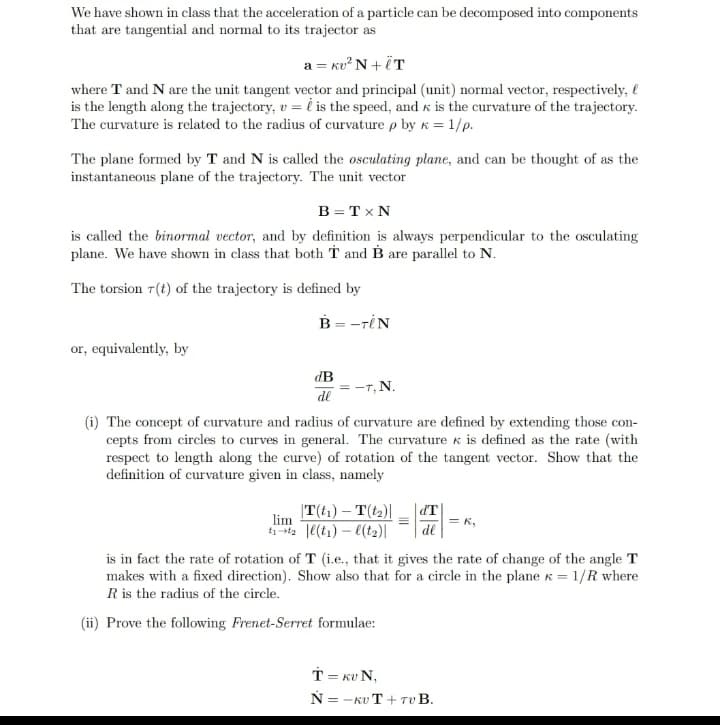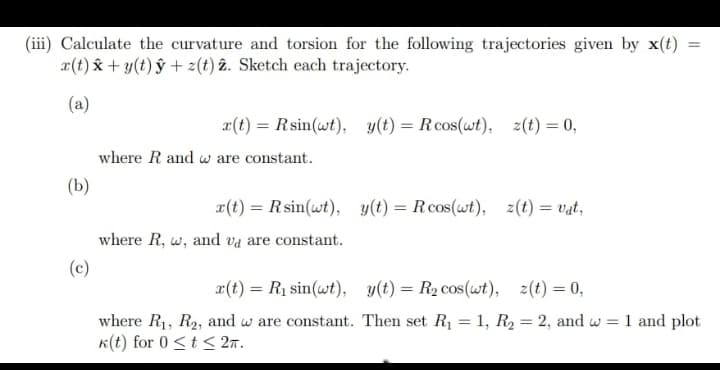We have shown in class that the acceleration of a particle can be decomposed into components that are tangential and normal to its trajector as a = kv²N+ÏT where T and N are the unit tangent vector and principal (unit) normal vector, respectively, is the length along the trajectory, v = is the speed, and is the curvature of the trajectory. The curvature is related to the radius of curvature p by k = 1/p. The plane formed by T and N is called the osculating plane, and can be thought of as the instantaneous plane of the trajectory. The unit vector B = TX N is called the binormal vector, and by definition is always perpendicular to the osculating plane. We have shown in class that both T and B are parallel to N. The torsion r(t) of the trajectory is defined by B = -TIN or, equivalently, by dB de = -T, N. (i) The concept of curvature and radius of curvature are defined by extending those con- cepts from circles to curves in general. The curvature is defined as the rate (with respect to length along the curve) of rotation of the tangent vector. Show that the definition of curvature given in class, namely |T(t₁) - T(t₂)| lim t₁-t₂|l(t₁) -l(t₂)| d'T de = K, is in fact the rate of rotation of T (i.e., that it gives the rate of change of the angle T makes with a fixed direction). Show also that for a circle in the plane x = 1/R where R is the radius of the circle.
We have shown in class that the acceleration of a particle can be decomposed into components that are tangential and normal to its trajector as a = kv²N+ÏT where T and N are the unit tangent vector and principal (unit) normal vector, respectively, is the length along the trajectory, v = is the speed, and is the curvature of the trajectory. The curvature is related to the radius of curvature p by k = 1/p. The plane formed by T and N is called the osculating plane, and can be thought of as the instantaneous plane of the trajectory. The unit vector B = TX N is called the binormal vector, and by definition is always perpendicular to the osculating plane. We have shown in class that both T and B are parallel to N. The torsion r(t) of the trajectory is defined by B = -TIN or, equivalently, by dB de = -T, N. (i) The concept of curvature and radius of curvature are defined by extending those con- cepts from circles to curves in general. The curvature is defined as the rate (with respect to length along the curve) of rotation of the tangent vector. Show that the definition of curvature given in class, namely |T(t₁) - T(t₂)| lim t₁-t₂|l(t₁) -l(t₂)| d'T de = K, is in fact the rate of rotation of T (i.e., that it gives the rate of change of the angle T makes with a fixed direction). Show also that for a circle in the plane x = 1/R where R is the radius of the circle.
Algebra & Trigonometry with Analytic Geometry
13th Edition
ISBN:9781133382119
Author:Swokowski
Publisher:Swokowski
Chapter11: Topics From Analytic Geometry
Section11.4: Plane Curves And Parametric Equations
Problem 33E
Related questions
Question
100%

Transcribed Image Text:We have shown in class that the acceleration of a particle can be decomposed into components
that are tangential and normal to its trajector as
a = kv²N+ÏT
where T and N are the unit tangent vector and principal (unit) normal vector, respectively,
is the length along the trajectory, v = is the speed, and is the curvature of the trajectory.
The curvature is related to the radius of curvature p by k = 1/p.
The plane formed by T and N is called the osculating plane, and can be thought of as the
instantaneous plane of the trajectory. The unit vector
B = TX N
is called the binormal vector, and by definition is always perpendicular to the osculating
plane. We have shown in class that both T and B are parallel to N.
The torsion r(t) of the trajectory is defined by
or, equivalently, by
B = -TIN
dB
de
= -T, N.
(i) The concept of curvature and radius of curvature are defined by extending those con-
cepts from circles to curves in general. The curvature & is defined as the rate (with
respect to length along the curve) of rotation of the tangent vector. Show that the
definition of curvature given in class, namely
|T(t₁) - T(t₂)|
lim
t₁-t₂|l(t₁) -l(t₂)|
d'T
de
= K,
is in fact the rate of rotation of T (i.e., that it gives the rate of change of the angle T
makes with a fixed direction). Show also that for a circle in the plane = 1/R where
R is the radius of the circle.
(ii) Prove the following Frenet-Serret formulae:
T = KUN,
N=-KUT + TUB.

Transcribed Image Text:(iii) Calculate the curvature and torsion for the following trajectories given by x(t)
x(t) x + y(t) ŷ + z(t) 2. Sketch each trajectory.
(a)
(b)
(c)
x(t) = Rsin(wt), y(t) = R cos(wt), z(t) = 0,
where R and w are constant.
r(t) = Rsin(wt), y(t) = Rcos(wt), z(t) = vat,
where R, w, and va are constant.
=
x(t) = R₁ sin(wt),
y(t) = R₂ cos(wt), z(t) = 0,
where R₁, R₂, and w are constant. Then set R₁ = 1, R₂ = 2, and w = 1 and plot
k(t) for 0 ≤ t ≤ 2π.
Expert Solution
This question has been solved!
Explore an expertly crafted, step-by-step solution for a thorough understanding of key concepts.
Step by step
Solved in 2 steps with 1 images

Recommended textbooks for you

Algebra & Trigonometry with Analytic Geometry
Algebra
ISBN:
9781133382119
Author:
Swokowski
Publisher:
Cengage

Algebra & Trigonometry with Analytic Geometry
Algebra
ISBN:
9781133382119
Author:
Swokowski
Publisher:
Cengage